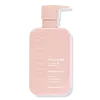What's inside
What's inside
 Key Ingredients
Key Ingredients

 Benefits
Benefits

 Concerns
Concerns

 Ingredients Side-by-side
Ingredients Side-by-side

Water
Skin ConditioningDisodium Laureth Sulfosuccinate
CleansingSodium C14-16 Olefin Sulfonate
CleansingCocamide Mea
EmulsifyingCocamidopropyl Hydroxysultaine
CleansingCocamidopropyl Betaine
CleansingGlycerin
HumectantPEG-7 Glyceryl Cocoate
EmulsifyingCocos Nucifera Oil
MaskingZingiber Officinale Root Extract
MaskingTocopheryl Acetate
AntioxidantCitric Acid
BufferingSodium Lauroyl Sarcosinate
CleansingDecyl Glucoside
CleansingPolyquaternium-7
Sodium Benzoate
MaskingSodium Chloride
MaskingSodium PCA
HumectantPEG-120 Methyl Glucose Dioleate
EmulsifyingEthylhexylglycerin
Skin ConditioningPhenoxyethanol
PreservativeBenzyl Alcohol
PerfumingTetradecene
EmollientBHT
AntioxidantDisodium EDTA
Sodium Sulfate
Hexyl Cinnamal
PerfumingSodium Sulfite
PreservativeHexadecene
SolventButylene Glycol
HumectantLinalool
PerfumingParfum
MaskingWater, Disodium Laureth Sulfosuccinate, Sodium C14-16 Olefin Sulfonate, Cocamide Mea, Cocamidopropyl Hydroxysultaine, Cocamidopropyl Betaine, Glycerin, PEG-7 Glyceryl Cocoate, Cocos Nucifera Oil, Zingiber Officinale Root Extract, Tocopheryl Acetate, Citric Acid, Sodium Lauroyl Sarcosinate, Decyl Glucoside, Polyquaternium-7, Sodium Benzoate, Sodium Chloride, Sodium PCA, PEG-120 Methyl Glucose Dioleate, Ethylhexylglycerin, Phenoxyethanol, Benzyl Alcohol, Tetradecene, BHT, Disodium EDTA, Sodium Sulfate, Hexyl Cinnamal, Sodium Sulfite, Hexadecene, Butylene Glycol, Linalool, Parfum
Water
Skin ConditioningAloe Barbadensis Leaf Extract
EmollientCoco-Glucoside
CleansingSodium Coco-Sulfate
CleansingGlycerin
HumectantLauryl Glucoside
CleansingPolyglyceryl-4 Caprate
EmulsifyingSodium Chloride
MaskingDiglycerin
HumectantBrassica Oleracea Italica Seed Oil
EmollientChamomilla Recutita Oil
MaskingEucalyptus Globulus Leaf/Twig Oil
MaskingLavandula Angustifolia Flower Extract
CleansingLavandula Angustifolia Oil
MaskingLavandula Hybrida Oil
EmollientRosmarinus Officinalis Leaf Oil
MaskingSalix Purpurea Bark Extract
Skin ConditioningLactobacillus Ferment
Skin ConditioningBeta-Sitosterol
Emulsion StabilisingSodium Hyaluronate
HumectantCoco-Caprylate
EmollientSqualene
EmollientGuar Hydroxypropyltrimonium Chloride
Skin ConditioningTocopherol
AntioxidantLactic Acid
BufferingSodium Hydroxide
BufferingParfum
MaskingLinalool
PerfumingWater, Aloe Barbadensis Leaf Extract, Coco-Glucoside, Sodium Coco-Sulfate, Glycerin, Lauryl Glucoside, Polyglyceryl-4 Caprate, Sodium Chloride, Diglycerin, Brassica Oleracea Italica Seed Oil, Chamomilla Recutita Oil, Eucalyptus Globulus Leaf/Twig Oil, Lavandula Angustifolia Flower Extract, Lavandula Angustifolia Oil, Lavandula Hybrida Oil, Rosmarinus Officinalis Leaf Oil, Salix Purpurea Bark Extract, Lactobacillus Ferment, Beta-Sitosterol, Sodium Hyaluronate, Coco-Caprylate, Squalene, Guar Hydroxypropyltrimonium Chloride, Tocopherol, Lactic Acid, Sodium Hydroxide, Parfum, Linalool
Ingredients Explained
These ingredients are found in both products.
Ingredients higher up in an ingredient list are typically present in a larger amount.
Glycerin is already naturally found in your skin. It helps moisturize and protect your skin.
A study from 2016 found glycerin to be more effective as a humectant than AHAs and hyaluronic acid.
As a humectant, it helps the skin stay hydrated by pulling moisture to your skin. The low molecular weight of glycerin allows it to pull moisture into the deeper layers of your skin.
Hydrated skin improves your skin barrier; Your skin barrier helps protect against irritants and bacteria.
Glycerin has also been found to have antimicrobial and antiviral properties. Due to these properties, glycerin is often used in wound and burn treatments.
In cosmetics, glycerin is usually derived from plants such as soybean or palm. However, it can also be sourced from animals, such as tallow or animal fat.
This ingredient is organic, colorless, odorless, and non-toxic.
Glycerin is the name for this ingredient in American English. British English uses Glycerol/Glycerine.
Learn more about GlycerinLinalool is a fragrance and helps add scent to products. It's derived from common plants such as cinnamon, mint, citrus, and lavender.
Like Limonene, this ingredient oxidizes when exposed to air. Oxidized linalool can cause allergies and skin sensitivity.
This ingredient has a scent that is floral, spicy tropical, and citrus-like.
Learn more about LinaloolParfum is a catch-all term for an ingredient or more that is used to give a scent to products.
Also called "fragrance", this ingredient can be a blend of hundreds of chemicals or plant oils. This means every product with "fragrance" or "parfum" in the ingredients list is a different mixture.
For instance, Habanolide is a proprietary trade name for a specific aroma chemical. When used as a fragrance ingredient in cosmetics, most aroma chemicals fall under the broad labeling category of “FRAGRANCE” or “PARFUM” according to EU and US regulations.
The term 'parfum' or 'fragrance' is not regulated in many countries. In many cases, it is up to the brand to define this term.
For instance, many brands choose to label themselves as "fragrance-free" because they are not using synthetic fragrances. However, their products may still contain ingredients such as essential oils that are considered a fragrance by INCI standards.
One example is Calendula flower extract. Calendula is an essential oil that still imparts a scent or 'fragrance'.
Depending on the blend, the ingredients in the mixture can cause allergies and sensitivities on the skin. Some ingredients that are known EU allergens include linalool and citronellol.
Parfum can also be used to mask or cover an unpleasant scent.
The bottom line is: not all fragrances/parfum/ingredients are created equally. If you are worried about fragrances, we recommend taking a closer look at an ingredient. And of course, we always recommend speaking with a professional.
Learn more about ParfumChances are, you eat sodium chloride every day. Sodium Chloride is also known as table salt.
This ingredient has many purposes in skincare: thickener, emulsifier, and exfoliator.
You'll most likely find this ingredient in cleansers where it is used to create a gel-like texture. As an emulsifier, it also prevents ingredients from separating.
There is much debate on whether this ingredient is comedogenic. The short answer - comedogenic ratings don't tell the whole story. Learn more about comegodenic ratings here.
The concensus about this ingredient causing acne seems to be divided. Research is needed to understand if this ingredient does cause acne.
Scrubs may use salt as the primary exfoliating ingredient.
Learn more about Sodium ChlorideWater. It's the most common cosmetic ingredient of all. You'll usually see it at the top of ingredient lists, meaning that it makes up the largest part of the product.
So why is it so popular? Water most often acts as a solvent - this means that it helps dissolve other ingredients into the formulation.
You'll also recognize water as that liquid we all need to stay alive. If you see this, drink a glass of water. Stay hydrated!
Learn more about Water